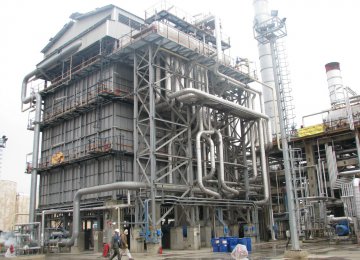To improve health and environmental standards at Tehran Oil Refinery, a nitrogen production unit has come on stream in the complex, director of Engineering and Planning Department at Tehran Oil Refining Company said.
“The newly-launched unit, with the capacity of producing 1,200 cubic meters of nitrogen per hour, will help the refinery replace natural gas with nitrogen in storage tanks to prevent the ignition of flammable liquids,” Mohammad Bidar was also quoted as saying by Shana on Wednesday.
Tehran Oil Refinery is located 15 kilometers south of the capital and includes two sections (southern refinery and northern one). Its nominal crude refining capacity stands at over 230,000 barrels a day. Pointing to environmental advantages of the project, Bidar said, "The unit will help save 8,000 tons of natural gas per year, which can reduce air pollution in a mega city like Tehran."
According to the official, natural gas is a strategic product that can be converted into value-added commodities, that is why it should not be wasted for trivial uses as long as nitrogen can be produced.
Used in both onshore and offshore situations, applications for nitrogen include well stimulation, injection and pressure testing, enhanced oil recovery (EOR), reservoir pressure maintenance, nitrogen floods and inert gas lift. Additionally, nitrogen is used to maintain pressure in reservoirs that have either been depleted of hydrocarbons
Referring to the company’s other eco-friendly steps, the official referred to replacing mazut with natural gas as fuel, installing a waste incineration unit, setting up oxygen analyzers on 34 furnaces and deploying online analyzers of pollutant gases on six other furnaces.
Tehran refinery is in the preliminary steps of cutting down its mazut production, with mazut making up around one-fifth of the facility's total output, but that amount is planned to be reduced to less than 10%.
Bidar said projects such as the monitoring of furnace combustion to lower fuel consumption, completion of a sour water stripper unit and a new steam line for optimizing production, distribution, consumption and maintenance of resources have so far come on stream in the refinery.
“The refinery has on its agenda the implementation of plans like boosting recycling capacity, replacing natural gas with nitrogen and installing the fourth bi-fuel turbine,” he said.











Add new comment
Read our comment policy before posting your viewpoints